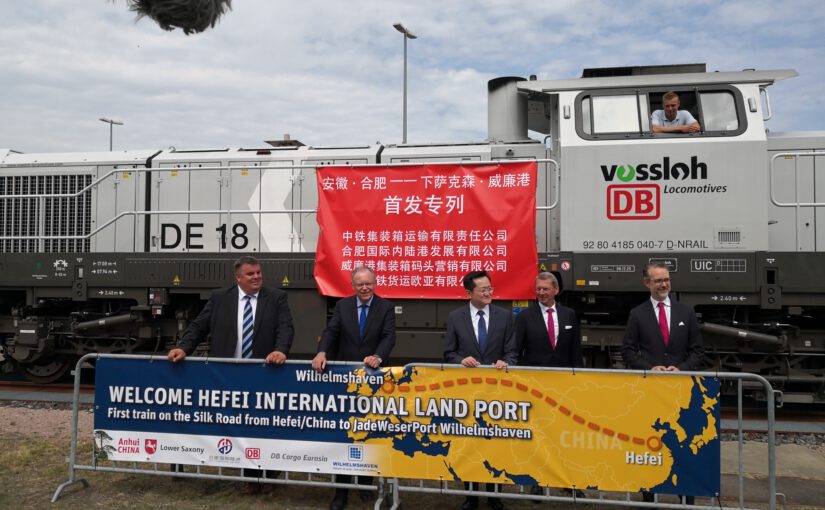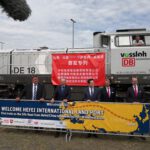Regional political leaders welcome the arrival of first freight train connecting Anhui province with northwestern Germany.
On 13 July 2021, at exactly 12:38 p.m., Lower Saxony state premier Stephan Weil and the mayor of the German coastal city of Wilhelmshaven, Carsten Feist, welcomed the first direct train from China on its arrival at the Jade-Weser-Port freight centre. Speaking of the importance of this new rail trade route, Stephan Weil praised this rail infrastructure project through Lower Saxony, saying that this new rail connection will play an active role in China’s “New Silk Road”.
Travelling via Kazakhstan, Russia, Belarus and Poland, the train took 19 days to travel from Hefei before reaching its final destination in Wilhelmshaven. The city of Hefei (合肥市) itself looks back on a very long history indeed. During the Chu kingdom (楚国), it was the site of a number of small states, first getting it name Hefei during the Han dynasty (汉朝 206BC-220AD), yet the city itself dates back to the Song Dynasty (宋朝 960-1279).
Today, it is the capital and largest city of the eastern Chinese province of Anhui (安徽省), home to eight million people. Hefei is a world-leading centre for scientific research and higher education. Many Chinese universities are located in the city. In 2015, Chancellor Angela Merkel visited Hefei University together with the Chinese Prime Minister, Li Keqiang (李克强).
Some of the former leaders of Lower Saxony, such as Ernst Albrecht, Sigmar Gabriel and Christian Wulff, have paid high-level visits to the Anhui’s capital, seeking to deepen ties between the German federal state and the eastern Chinese province. This collaboration between Lower Saxony and Anhui dates back to 1984, making it the oldest partnership between a German state and a province of the People’s Republic of China.
Wilhelmshaven, on the other hand, is a young city with around 77,000 inhabitants. Once planned as an important deep-water port by the Prussian King Wilhelm, who later became German Emperor Wilhelm I, it gained a reputation after the Second World War as a run-down city affected by depopulation and deprivation. Named after the Jade and Weser rivers which flow into the North Sea, the Jade-Weser-Port has started to breathe new life into the city since its inception in 2012. The port still has capacity to increase its freight consumption and has significant advantages over other ports. Head of the Jade-Weser-Port-Marketing GmbH, Andreas Bullwinkel, spoke of the advantages of Wilhelmshaven’s location, such as the short distance between the sea and the train network.
The Chinese Consul General, Mr. Du Xiaohui (杜哓晖), based in Hamburg, showcased the benefits of the new “Silk Road” in his speech. He spoke of Hefei and Wilhelmshaven as being bridgeheads of the “New Silk Road”, internationally known as “One Belt – One Road (一带一路)”. 140 countries and 32 organizations have signed up to the “One Belt – Road” initiative, which got underway in 2013.
The first train from Hefei to Wilhelmshaven carried one-hundred Twenty-Foot Equivalent Unit (TEU) containers with household items, electrical appliances and textile goods. From the perspective of retail companies in Germany and across Europe, rail transport is an interesting alternative, not least because the goods can be transported faster than by ship, which normally takes around 30 days from Shanghai to Wilhelmshaven via the Suez Canal.
Recent disruption to international shipping with the grounding of the Ever Given container ship in the Suez Canal has revealed shortcomings in conventional shipping routes to transport goods from Asia to Europe. As one of the world’s most important trading routes connecting the Red Sea with the Mediterranean Sea, the six-day blockage of the Suez Canal has an immediate knock-on impact of global supply chains. It did much to illustrate the vulnerability of what is the shortest sea link between Asia and Europe, highlighting the need for other trading routes to relieve the Suez Canal of the stresses and strains exerted by mega container ships. This is where the railways may well come into play, and gain in importance over the coming decades. Indeed, freight trains from China have been arriving regularly in German cities, such as Duisburg and Hamburg, since 2019. This new Trans-Eurasian trade route not only links Hefei and Wilhelmshaven, but also serves other cities on the route. This Hefei-Wilhelmshaven maiden journey saw containers being unloaded in Poland, for instance.
Many critical questions arise regarding the new Hefei-Wilhelmshaven trade route, including whether freight trains are a viable alternative to large cargo ships. Though freight trains may offer a less polluting form of transportation, they are unlikely to replace the dominant form of sea freight transport or become a major competitor. Train freight capacity is no match for a freighter that can transport up to 23,000 containers across the seas and oceans. And yet, space on freighters is becoming increasingly scarce and expensive, so much so that freight transportation by rail may be able to offer a cost-effective, though somewhat limited alternative, given the substantial difference in capacity carriage.
There are also the questions of who gains from such a trade route. Who precisely is the winner? Which countries benefit the most? The flow of goods on the railways between China and Germany is practically a one-sided venture as the demand for Chinese goods in Europe is so enormous. Chinese producers, then, use the route to supply their manufactured goods to the German and, more broadly, European markets. Use of the Jade-Weser-Port in Wilhelmshaven with its spare capacity lends itself to the storage and distribution of these incoming goods, especially considering its logistics trans-shipment centre which sells Chinese goods in Europe. Increased trade in Wilhelmshaven will undoubtedly lead to more employment opportunities in the local region, turning around the fortunes of a once run-down city.
The maiden Hefei-Wilhelmshaven journey is the initial first step with countless opportunities in the pipeline. Northwestern Germany itself can benefit on many levels. The second container train from the Chinese province Anhui has since arrived in Wilhelmshaven with companies taking advantage of available capacity in Wilhelmshaven. Whilst storage space has become scarce in Germany in recent years, Wilhelmshaven still has about 60 hectares of total 160 hectares still available. Many investors are bound to be reviewing their strategy. These developments are helping Wilhelmshaven to expand its network with the world. In doing so, it is seeking to move away from its reputation as a run-down city towards becoming a vibrant trading post with China and the wider world.


